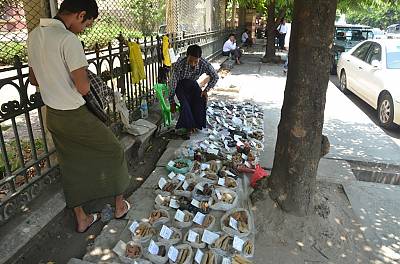- Myanmar


Traditional Medicine in Myanmar

© “Yangon.Médecine traditionnelle” by Antoine 49 is licensed under CC BY-NC-ND 2.0
1. ICH domains
Social practices, knowledge and practices concerning nature and the universe
2. Short description
Developed over millennia, traditional medicine in the Republic of the Union of Myanmar has been inherited through the different Myanmar civilisations, also drawing upon Buddhist healing practices, the practice of traditional Chinese medicine, and Ayurvedic concepts to promote holistic well-being grounded in traditional knowledge of nature and the universe.
During the colonial period (1885-1948), traditional medicinal knowledge declined following the introduction of allopathic Western medicines. It was, however, subsequently revived as the government and general populace recognized the effectiveness of traditional medicinal knowledge for healing a wide range of illnesses and diseases, using locally available plants instead of costly Western pharmaceuticals that were scarce during the Second World War.
In 1953, the Myanmar government established a Traditional Medicine Promotion Office under the Department of Health, and then in 1989, a separate Department of Traditional Medicine. The aims of the department are to provide comprehensive traditional medicinal services, develop standardized methods for traditional therapies, conduct research on traditional medicines and provide training for traditional practitioners. In keeping with these objectives, the department supports a national network of clinics as well as the University of Traditional Medicine located in Mandalay, which produces 250 practitioners per year. Myanmar also enacted a Traditional Medicine Law in 1996 and a Traditional Medical Council Law in 2000, and since 2007, has distributed traditional medicine first-aid kits in rural areas. Such medicine is produced both on mass scale by public and private sectors as well as by families themselves through home remedies such as herbal concoctions.
Further information:
The following document, available at the Southeast Asia Regional Office of the World Health Organization website, provides detailed information on traditional medicinal knowledge in Myanmar and the development of government initiatives to support traditional medicinal services (in English):
http://www.searo.who.int/entity/medicines/topics/traditional_medicine_in_union_of_myanmar.pdf
Articles on traditional medicines and their reception today in Myanmar can be found at the following links (in English):
https://www.mmtimes.com/special-features/208-health-2015/15164-taking-stock-of-traditional-med.html
http://www.thenewhumanitarian.org/report/86547/myanmar-new-lease-life-traditional-medicine
3. Link with sustainable development
The safeguarding and promotion of Myanmar’s traditional medicinal knowledge contributes to SDG 3 on ensuring healthy lives and well-being, while also supporting SDG 8, on promoting income generation and sustainable livelihoods. Widespread access to affordable, traditional medicines coupled with holistic healing practices offset the costs of healthcare for the general population, while support for the training of traditional practitioners provides decent work and promotes sustainable economic growth.
4. Questions for reflection
One risk for the continued transmission of traditional medicine in Myanmar is, possible misuse and health products falsely declared as herbal or natural. Furthermore, there is also the risk of overharvesting certain wild medicinal plants, as well as the use of endangered animals. The following article touches upon some of these issues:
https://www.mmbiztoday.com/articles/president-calls-development-traditional-medicine-industry
What can communities and groups concerned do to address these issues?
What kinds of policies and initiatives might help to mitigate some of the issues above, especially with regard to the over commercialization of traditional medicinal knowledge?